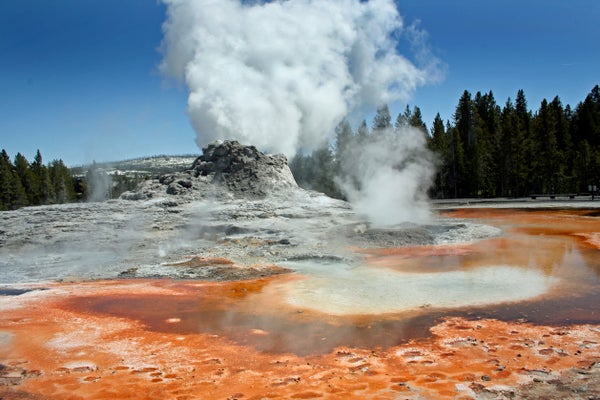Roughly 8.7 million years ago, in areas that would become southern Idaho and northern Nevada, the grasslands began to break open, unleashing curtains of lava and clouds of gas and ash that rolled across the North American landscape. Within hours, if not minutes, the land would have been pummeled by black volcanic glass that rained from above, killing animals such as rhinoceroses, camels, and horses that roamed the region and destroying plants. Soon the ground would cave in altogether. The event was the largest explosion ever from the supervolcano in Yellowstone National Park.
And scientists just found out about it. A recent study published in Geology identified evidence for this supereruption and estimated it was 30 percent larger than the previous record holder, which occurred 2.1 million years ago. Both eruptions were colossal. Supervolcanoes have the ability to destroy entire regions and send enough ash and gas into the air to alter the climate. The one at Yellowstone, scientists believe, is fueled by a column of hot rock that emerges from deep within the planet. As North America’s tectonic plate slowly drifts over that plume, the supervolcano’s surface activity moves from place to place. Over the past 16.5 million years, it has spouted major eruptions from Oregon to Wyoming. Today it powers Yellowstone’s simmering landscape of geysers and hot springs and is is often a favorite doomsday topic on social media and Web sites trafficking in rumors. The new research indicates the volcano’s history was even more violent than geologists had thought, but there are hints the hotspot could be waning in intensity.
[Read about the difference between supervolcanoes and smaller eruptions.]
On supporting science journalism
If you're enjoying this article, consider supporting our award-winning journalism by subscribing. By purchasing a subscription you are helping to ensure the future of impactful stories about the discoveries and ideas shaping our world today.
Researchers led by geochemist Thomas Knott of the University of Leicester in England first analyzed volcanic deposits that were previously believed to belong to smaller discrete eruptions. But when Knott and his colleagues took a closer look at the rocks—determining their chemical composition and age—it was clear that they shared the same origin. John Wolff, a volcanologist at Washington State University, who reviewed the new paper but was not directly involved in the research, calls the rock-matching work “first-class.” It took a significant effort from Knott’s team, with months spent in the field and an array of analytic techniques used back in the lab. “I don't know how many different ways you can look at rocks, but this is most of them,” says Michael McCurry, a geologist at Idaho State University.
The volcanic deposits were scattered across tens of thousands of square kilometers. Only a supereruption could spread gas and ash so far. “When you get your maps out and measure the scale, you think, ‘That can’t be right. They can’t possibly be that far apart and be from the same volcanic eruption,’” Knott says. “And when you realize they are, you realize just how insignificant you are in terms of the colossal power of things that nature can put upon us.”
The event, now dubbed the Grey’s Landing supereruption (after a spot in Idaho where the deposit is best preserved), likely ejected 2,800 cubic kilometers of material, Knott’s team calculated. So much ash and rock could fill nearly three quarters of the Grand Canyon. The amount places Grey’s Landing in the ranks of the top supereruptions of all time. And it puts the event on par with the infamous Toba superuption in Indonesia about 74,000 years ago, which some scientists have theorized may have brought humans to the brink of extinction.
The investigators also uncovered a second supereruption, which occurred nine million years ago and likely blew out 1,700 cubic kilometers of material. Although the extent of both that occurrence and Grey’s Landing are estimates, given that the team was not able to overturn every rock, Wolff agrees that it would be inconceivable for volcanic deposits to stretch across such vast distances unless they were created by supereruptions.
Knott’s team notes that these two events look vastly different from more recent Yellowstone eruptions. Not only were they larger, but they were also hotter and occurred in rapid succession. At that time, supereruptions ravaged the Yellowstone hotspot track once every 500,000 years. Today that rate has dropped to 1.5 million years. All clues indicate that Yellowstone was much more violent in its adolescence, and Knott’s next project is to find out why. Is the hotspot itself is dying out? Or is the continental crust above that plume thicker than it once was, providing a lid that dampened the most recent events?
Although the current rate of eruptions suggests that another explosion will not occur for roughly 900,000 years, Knott points out this estimate is simply a historical average, and it does not forecast how and when nature will act. “We don’t want to encourage complacency—nor do we want to fearmonger,” he says.
